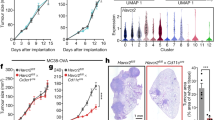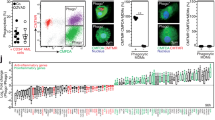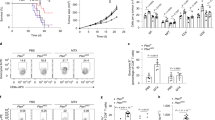Abstract
The therapeutic efficacy of anticancer chemotherapies may depend on dendritic cells (DCs), which present antigens from dying cancer cells to prime tumor-specific interferon-γ (IFN-γ)–producing T lymphocytes. Here we show that dying tumor cells release ATP, which then acts on P2X7 purinergic receptors from DCs and triggers the NOD-like receptor family, pyrin domain containing-3 protein (NLRP3)-dependent caspase-1 activation complex ('inflammasome'), allowing for the secretion of interleukin-1β (IL-1β). The priming of IFN-γ–producing CD8+ T cells by dying tumor cells fails in the absence of a functional IL-1 receptor 1 and in Nlpr3-deficient (Nlrp3−/−) or caspase-1–deficient (Casp-1−/−) mice unless exogenous IL-1β is provided. Accordingly, anticancer chemotherapy turned out to be inefficient against tumors established in purinergic receptor P2rx7−/− or Nlrp3−/− or Casp1−/− hosts. Anthracycline-treated individuals with breast cancer carrying a loss-of-function allele of P2RX7 developed metastatic disease more rapidly than individuals bearing the normal allele. These results indicate that the NLRP3 inflammasome links the innate and adaptive immune responses against dying tumor cells.
This is a preview of subscription content, access via your institution
Access options
Subscribe to this journal
Receive 12 print issues and online access
$209.00 per year
only $17.42 per issue
Buy this article
- Purchase on Springer Link
- Instant access to full article PDF
Prices may be subject to local taxes which are calculated during checkout






Similar content being viewed by others
References
Matzinger, P. The danger model: a renewed sense of self. Science 296, 301–305 (2002).
Savill, J., Dransfield, I., Gregory, C. & Haslett, C. A blast from the past: clearance of apoptotic cells regulates immune responses. Nat. Rev. Immunol. 2, 965–975 (2002).
Leadbetter, E.A. et al. Chromatin-IgG complexes activate B cells by dual engagement of IgM and Toll-like receptors. Nature 416, 603–607 (2002).
Lau, C.M. et al. RNA-associated autoantigens activate B cells by combined B cell antigen receptor/Toll-like receptor 7 engagement. J. Exp. Med. 202, 1171–1177 (2005).
Chen, C.J. et al. Identification of a key pathway required for the sterile inflammatory response triggered by dying cells. Nat. Med. 13, 851–856 (2007).
Akira, S., Uematsu, S. & Takeuchi, O. Pathogen recognition and innate immunity. Cell 124, 783–801 (2006).
Fritz, J.H., Ferrero, R.L., Philpott, D.J. & Girardin, S.E. Nod-like proteins in immunity, inflammation and disease. Nat. Immunol. 7, 1250–1257 (2006).
Medzhitov, R. Toll-like receptors and innate immunity. Nat. Rev. Immunol. 1, 135–145 (2001).
Beutler, B. et al. Genetic analysis of host resistance: Toll-like receptor signaling and immunity at large. Annu. Rev. Immunol. 24, 353–389 (2006).
Zitvogel, L., Apetoh, L., Ghiringhelli, F. & Kroemer, G. Immunological aspects of cancer chemotherapy. Nat. Rev. Immunol. 8, 59–73 (2008).
Obeid, M. et al. Calreticulin exposure is required for the immunogenicity of gamma-irradiation and UVC light-induced apoptosis. Cell Death Differ. 14, 1848–1850 (2007).
Banchereau, J. & Steinman, R.M. Dendritic cells and the control of immunity. Nature 392, 245–252 (1998).
Obeid, M. et al. Calreticulin exposure dictates the immunogenicity of cancer cell death. Nat. Med. 13, 54–61 (2007).
Lotze, M.T. et al. The grateful dead: damage-associated molecular pattern molecules and reduction/oxidation regulate immunity. Immunol. Rev. 220, 60–81 (2007).
Apetoh, L. et al. Toll-like receptor 4–dependent contribution of the immune system to anticancer chemotherapy and radiotherapy. Nat. Med. 13, 1050–1059 (2007).
Sancho, D. et al. Identification of a dendritic cell receptor that couples sensing of necrosis to immunity. Nature 458, 899–903 (2009).
Martinon, F. & Tschopp, J. Inflammatory caspases and inflammasomes: master switches of inflammation. Cell Death Differ. 14, 10–22 (2007).
Di Virgilio, F. Liaisons dangereuses: P2X7 and the inflammasome. Trends Pharmacol. Sci. 28, 465–472 (2007).
Eisenbarth, S.C., Colegio, O.R., O'Connor, W., Sutterwala, F.S. & Flavell, R.A. Crucial role for the Nalp3 inflammasome in the immunostimulatory properties of aluminium adjuvants. Nature 453, 1122–1126 (2008).
Agostini, L. et al. NALP3 forms an IL-1β–processing inflammasome with increased activity in Muckle-Wells autoinflammatory disorder. Immunity 20, 319–325 (2004).
Poyet, J.L. et al. Identification of Ipaf, a human caspase-1–activating protein related to Apaf-1. J. Biol. Chem. 276, 28309–28313 (2001).
Martinon, F., Burns, K. & Tschopp, J. The inflammasome: a molecular platform triggering activation of inflammatory caspases and processing of proIL-β. Mol. Cell 10, 417–426 (2002).
Sutterwala, F.S. et al. Critical role for NALP3/CIAS1/Cryopyrin in innate and adaptive immunity through its regulation of caspase-1. Immunity 24, 317–327 (2006).
Martinon, F., Petrilli, V., Mayor, A., Tardivel, A. & Tschopp, J. Gout-associated uric acid crystals activate the NALP3 inflammasome. Nature 440, 237–241 (2006).
Mariathasan, S. et al. Cryopyrin activates the inflammasome in response to toxins and ATP. Nature 440, 228–232 (2006).
Ferrari, D. et al. The P2X7 receptor: a key player in IL-1 processing and release. J. Immunol. 176, 3877–3883 (2006).
Kanneganti, T.D. et al. Critical role for Cryopyrin/Nalp3 in activation of caspase-1 in response to viral infection and double-stranded RNA. J. Biol. Chem. 281, 36560–36568 (2006).
Kanneganti, T.D. et al. Bacterial RNA and small antiviral compounds activate caspase-1 through cryopyrin/Nalp3. Nature 440, 233–236 (2006).
Ogura, Y., Sutterwala, F.S. & Flavell, R.A. The inflammasome: first line of the immune response to cell stress. Cell 126, 659–662 (2006).
Dinarello, C.A. Interleukin-1β, interleukin-18, and the interleukin-1β converting enzyme. Ann. NY Acad. Sci. 856, 1–11 (1998).
Brydges, S. & Kastner, D.L. The systemic autoinflammatory diseases: inborn errors of the innate immune system. Curr. Top. Microbiol. Immunol. 305, 127–160 (2006).
Reginato, A.M. & Olsen, B.R. Genetics and experimental models of crystal-induced arthritis. Lessons learned from mice and men: is it crystal clear? Curr. Opin. Rheumatol. 19, 134–145 (2007).
McIntyre, K.W. et al. Inhibition of interleukin 1 (IL-1) binding and bioactivity in vitro and modulation of acute inflammation in vivo by IL-1 receptor antagonist and anti–IL-1 receptor monoclonal antibody. J. Exp. Med. 173, 931–939 (1991).
Selzner, N. et al. Water induces autocrine stimulation of tumor cell killing through ATP release and P2 receptor binding. Cell Death Differ. 11 (Suppl 2), S172–S180 (2004).
Solle, M. et al. Altered cytokine production in mice lacking P2X7 receptors. J. Biol. Chem. 276, 125–132 (2001).
Srinivasula, S.M. et al. The PYRIN-CARD protein ASC is an activating adaptor for caspase-1. J. Biol. Chem. 277, 21119–21122 (2002).
Koebel, C.M. et al. Adaptive immunity maintains occult cancer in an equilibrium state. Nature 450, 903–907 (2007).
Gu, B.J. et al. A Glu-496 to Ala polymorphism leads to loss of function of the human P2X7 receptor. J. Biol. Chem. 276, 11135–11142 (2001).
Sluyter, R., Shemon, A.N. & Wiley, J.S. Glu496 to Ala polymorphism in the P2X7 receptor impairs ATP-induced IL-1β release from human monocytes. J. Immunol. 172, 3399–3405 (2004).
Bours, M.J., Swennen, E.L., Di Virgilio, F., Cronstein, B.N. & Dagnelie, P.C. Adenosine 5′-triphosphate and adenosine as endogenous signaling molecules in immunity and inflammation. Pharmacol. Ther. 112, 358–404 (2006).
Blankenstein, T. The role of tumor stroma in the interaction between tumor and immune system. Curr. Opin. Immunol. 17, 180–186 (2005).
Hinrichs, C.S., Gattinoni, L. & Restifo, N.P. Programming CD8+ T cells for effective immunotherapy. Curr. Opin. Immunol. 18, 363–370 (2006).
Ferrari, D., Chiozzi, P., Falzoni, S., Hanau, S. & Di Virgilio, F. Purinergic modulation of interleukin-1β release from microglial cells stimulated with bacterial endotoxin. J. Exp. Med. 185, 579–582 (1997).
Adachi, O. et al. Targeted disruption of the Myd88 gene results in loss of IL-1– and IL-18–mediated function. Immunity 9, 143–150 (1998).
Franchi, L., Kanneganti, T.D., Dubyak, G.R. & Nunez, G. Differential requirement of P2X7 receptor and intracellular K+ for caspase-1 activation induced by intracellular and extracellular bacteria. J. Biol. Chem. 282, 18810–18818 (2007).
Muruve, D.A. et al. The inflammasome recognizes cytosolic microbial and host DNA and triggers an innate immune response. Nature 452, 103–107 (2008).
Pétrilli, V., Dostert, C., Muruve, D.A. & Tschopp, J. The inflammasome: a danger sensing complex triggering innate immunity. Curr. Opin. Immunol. 19, 615–622 (2007).
Krelin, Y. et al. Interleukin-1β–driven inflammation promotes the development and invasiveness of chemical carcinogen-induced tumors. Cancer Res. 67, 1062–1071 (2007).
Hagemann, T., Balkwill, F. & Lawrence, T. Inflammation and cancer: a double-edged sword. Cancer Cell 12, 300–301 (2007).
Greten, F.R. et al. IKKβ links inflammation and tumorigenesis in a mouse model of colitis-associated cancer. Cell 118, 285–296 (2004).
Naugler, W.E. et al. Gender disparity in liver cancer due to sex differences in MyD88-dependent IL-6 production. Science 317, 121–124 (2007).
Balkwill, F., Charles, K.A. & Mantovani, A. Smoldering and polarized inflammation in the initiation and promotion of malignant disease. Cancer Cell 7, 211–217 (2005).
Acknowledgements
We thank I. Couillin (CNRS) and A. Mignon (Cochin Hospital) for helpful discussion and for providing IL-1RA, R. Schreiber (Washington University School of Medicine) for monoclonal antibodies to IL-1α, IL-1β and IL-1R, H. Yang (Feinstein Institute for Medical Research) for antibody to HMGB1, H. Yagita (School of Medicine, Juntendo University) for the N2B2 antibody to mouse TRAIL, J.-C. Guéry (INSERM) for IL12rb2−/− mice, V. Dixit (Pennington Biomedical Research Center) for Pycard−/− mice, M. Albert (Pasteur Institute) for membrane-bound OVA–transfected mouse embryonic fibroblast cells, S. Forget and J. Bombled for access to the genomics platform, V. Vasseur and the Institut Gustave Roussy animal facility for breeding of transgenic mice, I. Martins for help in ATP release screening and A. Boissonnas (INSERM, Curie Institute) for providing OT1-GFP mice. We are deeply indebted to P. Arveux and S. Dabakuyo for useful help with the statistical analyses. The authors are supported by grants from the Ligue Nationale contre le Cancer (to L. Aymeric., G.K. and L.Z.), the Fondation pour la Recherche Médicale (to L. Apetoh., G.K., E.U., F.S. and L.Z.), the European Union (INFLACARE grant), the association for International cancer research (to G.K.) Cancéropôle Ile-de-France, Institut National du Cancer (L.Z., G.K.), Agence Nationale pour la Recherche (to G.K.), the European Molecular Biology Organization (L. Apetoh.), INSERM (A.T.), the National Health, Association pour la recherche sur le cancer RC (to G.M.), National Health and Medical Research Council of Australia, Cancer Council of Victoria, the China Scholarship Council (Y.M.) and the Leukemia Foundation (M.J.S., N.M.M. and N.M.H.). K.V. is the recipient of a European Respiratory Society Fellowship (number 605).
Author information
Authors and Affiliations
Contributions
F.G., L. Aymeric., A.T., L. Apetoh., T.P., F.S., G.M., E.U., Y.M., N.M.M., N.M.H. and M.J.S. performed in vitro and in vivo experiments. C.O., E.T., P.G. and A.C. performed in vitro experiments. A.T. and T.P. performed immunofluorescence experiments. M.U., J.-L.P., B.R., J.K. and J.T. provided transgenic cells or mice and gave scientific advice. K.V., F.A., R.L., F.G. and A.T. performed the single nucleotide polymorphism analysis on cohorts of subjects with cancer. F.G., L. Apetoh., M.J.S. and A.T. prepared the figures and drafted the manuscript. G.K. and L.Z. designed the study and wrote the manuscript. M.J.S., G.K. and L.Z. all contributed equally to the design of the experiments and to the writing of the manuscript.
Corresponding authors
Supplementary information
Supplementary Text and Figures
Supplementary Figures 1–8, Supplementary Table 1 and Supplementary Methods (PDF 2928 kb)
Rights and permissions
About this article
Cite this article
Ghiringhelli, F., Apetoh, L., Tesniere, A. et al. Activation of the NLRP3 inflammasome in dendritic cells induces IL-1β–dependent adaptive immunity against tumors. Nat Med 15, 1170–1178 (2009). https://doi.org/10.1038/nm.2028
Received:
Accepted:
Published:
Issue Date:
DOI: https://doi.org/10.1038/nm.2028
This article is cited by
-
TNFα modulates PANX1 activation to promote ATP release and enhance P2RX7-mediated antitumor immune responses after chemotherapy in colorectal cancer
Cell Death & Disease (2024)
-
Targeting immunogenic cell stress and death for cancer therapy
Nature Reviews Drug Discovery (2024)
-
Shikonin improves the effectiveness of PD-1 blockade in colorectal cancer by enhancing immunogenicity via Hsp70 upregulation
Molecular Biology Reports (2024)
-
Purinergic pathways and their clinical use in the treatment of acute myeloid leukemia
Purinergic Signalling (2024)
-
Tumor-derived interleukin-1 receptor antagonist exhibits immunosuppressive functions and promotes pancreatic cancer
Cell & Bioscience (2023)



